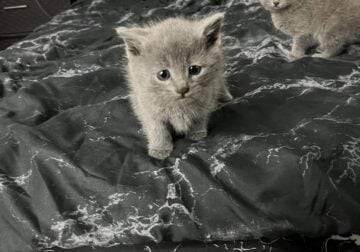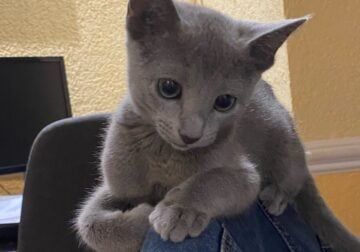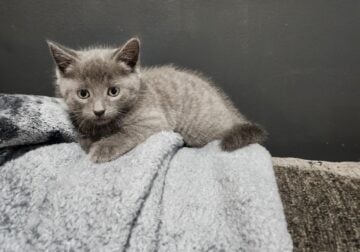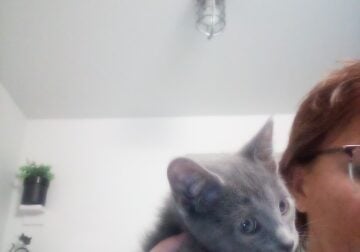Russian Blue Kittens for Sale: Regal Appearance and Dignified Demeanor
Pet owners find Russian Blues highly desirable because of their unique, shimmery blue coats. More than their beautiful looks, Russian Blue Cats are loving and loyal with quiet dignity. They can be medium-sized or large cats with average energy levels and exceptional friendliness toward other pets.
Overview of Russian Blue
Russian Blue cats are average-sized or large, ranging from eight to fifteen pounds. They are renowned for the blue-gray coats that gave them their name.
Other Names
You may find a blue Russian cat for sale under a few names.
- Russian Blue – most common and well-known
- Russian Blue Cat
- Maltese Cat – rare
- Archangel Cat – historical significance
- Archangel Blue
- Foreign Blue
- Arkhangelsk Cat
History
The Russian Blue was a naturally occurring or landrace cat thought to have originated on an island in Northwestern Russia called Arkhangelsk or Archangel. England receives most of the credit for developing the modern form of the breed, although Scandinavia also developed a family of Russian Blue cats. Traders may have begun bringing cats to England as early as 1860. In the 1870s, Russian Blues competed under the generic category for all blue cats, including ancestors of the British Shorthair. Regardless of their history, Russian Blue cats became a separate breed in 1912. They suffered from decimated populations after World War II. Early revival attempts involved Siamese infusions. American fanciers helped reestablish the purebred Russian Blue cat with crosses between British and Scandinavian lines.
Appearance
A Russian Blue’s head should be distinct, resembling the Siamese cat slightly with a moderate wedge shape. The profile descends smoothly from the flattened top of the head to the nose with no discernible stop. Unlike a Siamese, the Russian Blue has a blunt muzzle that is a little shorter than its backskull. The eyes are wide-set and round while the ears are large and broad at the base. Russian Blue cats for sale have pointed ears that have minimal fuzz. A Russian Blue has a long graceful neck that allows for an upright head carriage, but its length is obscured by high shoulder blades and dense fur. A major distinction between the Russian and British Blue is the former has a slight frame with slender legs. Because of its musculature, a Russian Blue for sale is better described as lithe rather than lean or petite. Its paws are notably small and round. Finally, its tail is long and tapering and appears in proportion to its body.
Coat
All Russian Blues have a short, plush, dual coat that is weather resistant. The thick undercoat serves as an insulating layer against hot and cold temperatures. A Russian Blue’s fur is fine but stands off from the body, giving the cat a fluffy look. Russian Blues feel velvety soft.
Colors
True to its name, the only color you can register for a Russian Blue is blue. The color can range from light silvery-blue to steel grayish-blue to dark slate gray. Show judges prefer lighter colors. Unlike blue British Shorthairs which are one solid shade from the underfur to the outermost guard hairs, Russian Blues exhibit tipping. As part of the breed standard, the Russian Blue’s hairs are tipped with a lighter shade than the remainder of the fur. This gives the Russian Blue a characteristic silvery, shimmery appearance. It has vivid green to emerald eyes, although they are blue followed by yellow in young kittens. Russian Blue kittens for sale may display the first signs of this adult eye color before you bring one home. They develop a green ring in the iris around the age of 16 weeks.
Personality
Like everything else about it, the Russian Blue’s personality is unique. It is loyal and interactive, in some ways like a dog. However, it retains the independence and ability to keep its own company like many cat breeds. Russian blues tend to be shy around strangers and adverse to loud noises. They are adaptable to condominiums, spacious homes, and small apartments but are not fond of changes in daily routines. Russian Blues are exceedingly affectionate when in the mood for attention but can also be unexpectedly aloof. While they will be loving to all family members, they tend to bond most closely to one person. Russian Blues are friendly toward other cats. They do remarkably well with a housemate if socialized early. Likewise, Russian Blues are accepting of quiet, laid-back dogs and gentle kids.
Lifespan
Russian Blues are healthy, long-lived cats with a life expectancy between 15 and 18 years. A few have been known to live to the ripe old age of 25 years.
Russian Blue Kittens for Sale Near Me
When you consider kittens from a local litter of Russian Blues, you need pedigree papers or a reputable breeder to ensure you get the type of cat you seek. Unethical sellers and pet stores may pass off gray and blue cats as Russian Blues. Do your research on breeders and realize that blue is not an uncommon color for domesticated cats. Once you have established that prospective kittens are Russian Blues, look for animals that are active, alert, and in good flesh. The eyes and noses of all littermates should be clear. Russian Blue kittens for sale should have undergone veterinarian exams, parasite control measures, and vaccinations. They should be free from diarrhea and ear mites.
Care
Russian Blue cats for sale are low-maintenance pets. They demand attention when you are home but can be alone for extended periods during the day. Even if you do not leave much, Russian Blues need some time to themselves. Their additional care requirements are like those of other short-haired cats.
Exercise
Russian Blues are moderately active. They do not require much encouragement to play but will likely keep any interactive sessions short. Russian Blues respond well to lasers and other lures. Kittens, unsurprisingly, play longer and more vigorously than mature cats, but adults are not couch potatoes. Ensuring your cat remains active will help prevent it from becoming overweight. Not only does activity burn calories, but it may prevent boredom that leads to overeating.
Feeding
Cat owners disagree about whether to feed their cats wet or dry food. Many cats prefer to graze throughout the day, and kibble allows owners to exercise free feeding. However, cats tend to under-consume water. Therefore, canned or raw food is a great way to provide increased dietary moisture. Making sure your cat gets enough water is one way to prevent urinary crystals. Russian Blues require a meat-based low-fat diet, approximating the composition of a small rodent or rabbit. Russian Blues need 240 to 360 calories a day or about one to one-and-a-half six-ounce cans of wet food. You can feed your cat all of her food at once or split it into two or three meals. If you leave some dry food out throughout the day, you must adjust the amount of canned food accordingly. Fresh food requirements are a little less than those for canned diets (2.5 to 2.25 ounces). Kittens need 60 to 65 calories per pound every day and should have several meals in a 24-hour period. Moreover, kittens require a higher fat content than adults to provide energy and help them maintain their weight.
Grooming
You should brush your Russian Blue cat weekly to remove loose fur and improve the coat’s shine through the distribution of natural oils. Brushing your cat needs to increase during periods of heavy shedding such as occur going into summer and winter. Russian Blues do not need frequent baths as they are capable of effective self-grooming. Most recommendations call for shampooing your cat every six to twelve weeks or less. You should also trim your cat’s nails every two to six weeks and brush its teeth every few days. Cats do not naturally take to dental hygiene, so you must train your pet as a kitten to tolerate either a tiny toothbrush or a bristled finger glove. Other grooming tasks should include periodically wiping your cat’s face and checking its ears for abnormal debris and signs of infection.
Training
Although Russian Blues are exceptionally intelligent, they are not the easiest cats to train. They are independent and, at times, too cautious to take direction. During your training sessions with your Russian Blue, your best chance at a breakthrough comes if you take advantage of your cat’s love of your company, perceptiveness, and high environmental awareness. For example, allow your cat to climb towers during a learning activity.



























